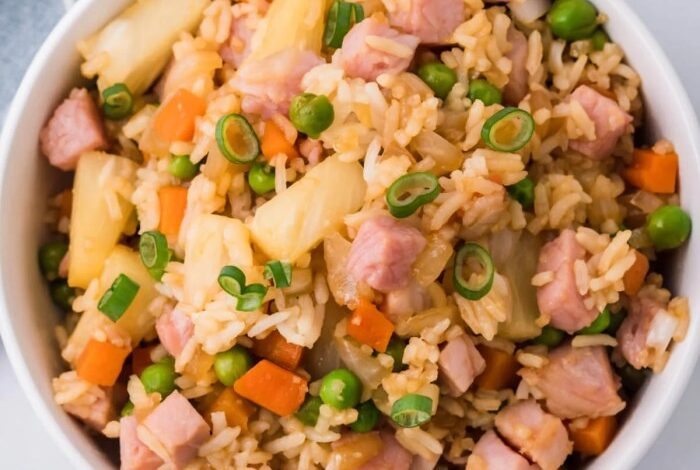
Pineapple Fried Rice with Ham: A Culinary Journey
Pineapple fried rice with ham is a dish that transcends borders and cultures, a testament to the universal appeal of flavorful, satisfying food. This iconic dish, often enjoyed as a comforting meal or a vibrant side, is a delightful fusion of sweet, savory, and tangy notes.
From its humble origins to its global presence, pineapple fried rice with ham has captured hearts and stomachs worldwide, evolving with each region it calls home.
The dish’s history is a fascinating tapestry woven from diverse culinary influences. The use of rice as a staple, the savory embrace of ham, and the tropical touch of pineapple all contribute to a dish that is both familiar and exotic.
The combination of these ingredients, a symphony of textures and flavors, has led to countless variations and regional interpretations, each adding its own unique twist to this beloved classic.
History and Origin

Pineapple fried rice with ham is a delicious and popular dish that has a rich history and fascinating cultural influences. It’s a fusion of flavors and techniques from different parts of the world, resulting in a truly unique culinary creation.
Origins of Pineapple Fried Rice with Ham
The origins of pineapple fried rice with ham can be traced back to the fusion of Chinese and Western culinary traditions. While the exact origins are unclear, it’s likely that the dish emerged in the 20th century, during a period of increased globalization and cultural exchange.
- Chinese Fried Rice: The foundation of pineapple fried rice is, of course, Chinese fried rice. This dish has a long history, dating back to the Song Dynasty (960-1279 AD). It’s believed that fried rice was initially created as a way to use leftover cooked rice, making it a practical and economical dish.
- Western Influences: The addition of ham and pineapple is a distinctly Western influence. Ham is a common ingredient in Western cuisine, and pineapple was introduced to the West by Christopher Columbus in the 15th century. The combination of these ingredients likely emerged in the 20th century, as Western culinary influences became more prevalent in Asian cuisine.
Cultural Influences
Pineapple fried rice with ham reflects a blend of cultural influences that have shaped its unique character.
- Chinese Cuisine: The dish’s base of fried rice with vegetables is a testament to the influence of Chinese culinary traditions. The use of soy sauce, sesame oil, and other traditional Chinese seasonings adds depth and complexity to the flavor profile.
Pineapple fried rice with ham is a classic comfort food for me. It’s always a satisfying meal, especially when paired with something tangy and refreshing. I recently discovered a recipe for phoenicians key lime pie that I think would be the perfect complement.
The bright citrus flavors would cut through the richness of the rice and ham, making for a truly delightful combination.
- Western Cuisine: The addition of ham and pineapple brings a distinctly Western touch to the dish. These ingredients add sweetness, saltiness, and a touch of acidity, creating a harmonious balance of flavors.
- Southeast Asian Cuisine: The use of pineapple as a key ingredient also suggests influences from Southeast Asian cuisine, where pineapple is a popular fruit used in both sweet and savory dishes.
Historical Context
The combination of ingredients in pineapple fried rice with ham reflects the historical context of the dish’s origins.
- Globalization: The 20th century witnessed a significant increase in globalization, leading to greater cultural exchange and the fusion of culinary traditions. This exchange led to the development of new dishes, like pineapple fried rice with ham, which blended elements from different cultures.
- Immigration: The migration of people from different parts of the world also played a role in the development of this dish. Immigrants brought their culinary traditions with them, sharing their recipes and techniques with others. This cultural exchange led to the creation of hybrid dishes that reflected the diverse culinary landscape of their new home.
Variations and Regional Differences
Pineapple fried rice with ham is a beloved dish around the world, and each region has its own unique take on this classic recipe. These variations often reflect local culinary traditions and readily available ingredients, resulting in diverse flavor profiles and cooking techniques.
Regional Variations
The variations in pineapple fried rice with ham often stem from the specific ingredients used and the cooking methods employed. Here’s a look at some prominent regional styles:
Thai Pineapple Fried Rice
Thai pineapple fried rice is known for its vibrant flavors and aromatic profile. Key ingredients include:
- Jasmine rice: This long-grain rice is a staple in Thai cuisine, known for its fluffy texture and delicate flavor.
- Fish sauce: A fermented fish condiment that adds a savory umami note to the dish.
- Shrimp paste: This ingredient adds a pungent and complex flavor that is characteristic of Thai cuisine.
- Chilis: Thai cuisine often incorporates chilies for a spicy kick, which can be adjusted to personal preference.
- Lemongrass: This fragrant herb adds a citrusy and slightly peppery note to the dish.
- Kaffir lime leaves: These leaves impart a unique citrusy aroma and subtle bitterness.
Thai pineapple fried rice is typically cooked in a wok, using high heat to achieve a crispy texture for the rice. The ingredients are stir-fried quickly, ensuring that each element retains its individual flavor and texture.
Pineapple fried rice with ham is a classic comfort food that always hits the spot. It’s a great way to use up leftover rice and ham, and it’s so easy to make. I’m always looking for new ways to use my air fryer, and recently I discovered a recipe for air fryer pasta chips that was absolutely amazing! They’re crispy and flavorful, and they’re the perfect snack to enjoy alongside a plate of pineapple fried rice.
Chinese Pineapple Fried Rice
Chinese pineapple fried rice, particularly from the Cantonese region, often incorporates:
- Long-grain rice: This type of rice is commonly used in Chinese cuisine, providing a neutral base for the flavors of the other ingredients.
- Soy sauce: A staple in Chinese cooking, soy sauce adds a salty and savory flavor to the dish.
- Oyster sauce: This thick, savory sauce adds a umami depth to the dish, particularly popular in Cantonese cuisine.
- Ginger: This aromatic root adds a spicy and pungent note to the dish.
- Scallions: These green onions add a fresh and slightly sweet flavor to the dish.
The cooking method for Chinese pineapple fried rice often involves stir-frying the ingredients in a wok, achieving a crispy texture for the rice. However, some variations may use a frying pan, depending on the regional preference.
Filipino Pineapple Fried Rice
Filipino pineapple fried rice, known as “Pinoy Fried Rice,” is a popular dish that often incorporates:
- White rice: This type of rice is widely used in Filipino cuisine, providing a neutral base for the flavors of the other ingredients.
- Patis (fish sauce): This fermented fish condiment adds a savory umami note to the dish.
- Soy sauce: A staple in Filipino cooking, soy sauce adds a salty and savory flavor to the dish.
- Garlic: This aromatic bulb adds a pungent and savory flavor to the dish.
- Onions: These add a sweet and slightly pungent flavor to the dish.
- Tomato sauce: This ingredient adds a tangy and slightly sweet flavor to the dish.
Filipino pineapple fried rice is often cooked in a wok or frying pan, using high heat to achieve a crispy texture for the rice. The ingredients are stir-fried quickly, ensuring that each element retains its individual flavor and texture.
Hawaiian Pineapple Fried Rice
Hawaiian pineapple fried rice is a fusion dish that incorporates elements of both Asian and Western cuisines. Key ingredients include:
- White rice: This type of rice is commonly used in Hawaiian cuisine, providing a neutral base for the flavors of the other ingredients.
- Soy sauce: A staple in Hawaiian cooking, soy sauce adds a salty and savory flavor to the dish.
- Teriyaki sauce: This sweet and savory sauce is a popular ingredient in Hawaiian cuisine, adding a distinct flavor to the dish.
- Macadamia nuts: These nuts add a creamy and nutty flavor to the dish, a unique element of Hawaiian cuisine.
Hawaiian pineapple fried rice is often cooked in a wok or frying pan, using high heat to achieve a crispy texture for the rice. The ingredients are stir-fried quickly, ensuring that each element retains its individual flavor and texture.
Pineapple fried rice with ham is a classic dish that always brings back happy memories. The sweet and savory flavors of the pineapple, ham, and rice are a perfect combination. But sometimes, you crave something a little more hearty and smoky, like bbq country style ribs.
After indulging in those ribs, though, there’s nothing quite like the refreshing simplicity of a plate of pineapple fried rice to finish off the meal.
Other Regional Variations
There are many other regional variations of pineapple fried rice with ham, each with its own unique characteristics. For example, some variations may include:
- Spicy sausage: Adding a spicy kick to the dish, often used in Southeast Asian variations.
- Peas and carrots: Adding a touch of sweetness and color to the dish, often used in Chinese variations.
- Curry powder: Adding a fragrant and spicy note to the dish, often used in Indian variations.
Ingredients and Preparation
Pineapple fried rice with ham is a delicious and versatile dish that can be customized to your liking. It’s a great way to use up leftover rice and is perfect for a quick and easy weeknight meal.
Ingredients and Preparation Steps
The key to a great pineapple fried rice is using fresh, high-quality ingredients. Here is a detailed recipe for pineapple fried rice with ham, organized into a table with columns for ingredient, quantity, and preparation steps:
| Ingredient | Quantity | Preparation Steps |
|---|---|---|
| Cooked rice | 2 cups | Use leftover rice or freshly cooked rice that has been cooled to room temperature. |
| Ham | 1/2 cup, diced | Choose a good quality ham, such as a honey ham or a spiral-sliced ham. |
| Pineapple | 1 cup, diced | Choose a ripe pineapple with a sweet aroma. |
| Onion | 1/2 cup, diced | Choose a white or yellow onion. |
| Garlic | 2 cloves, minced | Use fresh garlic for the best flavor. |
| Eggs | 2 | Beat the eggs lightly with a fork. |
| Soy sauce | 2 tablespoons | Use a good quality soy sauce. |
| Oyster sauce | 1 tablespoon | Oyster sauce adds a savory depth of flavor. |
| Vegetable oil | 2 tablespoons | Use a neutral-flavored oil, such as canola or vegetable oil. |
| Salt and pepper | To taste | Add salt and pepper to your liking. |
| Chopped green onions | For garnish | Garnish with chopped green onions for a fresh flavor and visual appeal. |
Cooking Techniques
The success of pineapple fried rice with ham relies heavily on the right cooking techniques. Stir-frying is the key to achieving the desired texture and flavors. Here’s a step-by-step guide to help you master this classic dish.
Stir-Frying Rice and Vegetables
Stir-frying is a fast and efficient cooking method that requires a hot wok or skillet and constant movement. The high heat sears the ingredients, creating a flavorful crust while maintaining their crispness.
- Use a hot wok or skillet: Heat the wok or skillet over high heat for a few minutes until it is very hot. This ensures that the ingredients cook quickly and evenly, preventing them from becoming soggy.
- Add oil: Add a generous amount of oil to the hot wok or skillet. The oil should be hot enough to sizzle when you add the ingredients.
- Stir-fry the vegetables: Add the vegetables, such as onions, carrots, peas, and bean sprouts, to the hot oil and stir-fry for 2-3 minutes, or until they are tender-crisp. Stir-frying the vegetables first allows them to release their flavors and cook evenly.
- Add the rice: Add the cooked rice to the wok or skillet and stir-fry for 2-3 minutes, or until it is heated through and lightly toasted. Be sure to break up any clumps of rice and ensure it is evenly coated with the oil and vegetables.
- Season with soy sauce and other seasonings: Add soy sauce, fish sauce, oyster sauce, and other seasonings to taste. Stir-fry for another minute to allow the flavors to meld.
Cooking the Ham and Pineapple
- Dice the ham: Cut the ham into small, bite-sized pieces. This will ensure that it cooks evenly and is easy to eat.
- Fry the ham: Add the diced ham to the wok or skillet and stir-fry for 1-2 minutes, or until it is cooked through and lightly browned. This step adds a savory flavor and a slightly crispy texture to the dish.
- Add the pineapple: Add the pineapple chunks to the wok or skillet and stir-fry for 1-2 minutes, or until they are heated through and slightly softened. The pineapple adds a sweet and tangy flavor to the dish, balancing out the savory flavors of the ham and rice.
Assembling and Serving
- Combine all ingredients: Combine the stir-fried rice, vegetables, ham, and pineapple in the wok or skillet and stir-fry for another minute to ensure everything is well combined and heated through.
- Serve immediately: Serve the pineapple fried rice with ham hot, garnished with chopped green onions or cilantro, if desired. It can be enjoyed as a main course or as a side dish.
Flavor Profiles and Pairings
Pineapple fried rice with ham is a dish that harmoniously blends sweet, savory, and tangy notes, creating a flavorful and satisfying experience. The dish’s unique taste profile arises from the interplay of its key ingredients, each contributing its own distinct flavor element.
Dominant Flavors and Contributions
The dominant flavors in pineapple fried rice with ham are:
- Sweetness: Pineapple, a key ingredient, contributes a natural sweetness that balances the savory flavors of the dish. The sweetness is further enhanced by the addition of sugar or other sweeteners during the cooking process.
- Savory: Ham, a common addition, provides a salty and umami flavor that adds depth and complexity to the dish. The savory notes are further amplified by the use of soy sauce, fish sauce, or other savory seasonings.
- Tangy: The addition of pineapple juice or vinegar adds a tangy note that cuts through the sweetness and savory flavors, creating a refreshing balance. This tanginess also helps to brighten the overall taste profile.
Accompaniments and Beverages, Pineapple fried rice with ham
The vibrant flavors of pineapple fried rice with ham make it an ideal dish for pairing with a variety of accompaniments and beverages.
- Accompaniments: The dish can be served with a side of steamed vegetables, such as broccoli, carrots, or snap peas, for a balanced meal. It can also be enjoyed with a light salad, adding a refreshing touch to the overall dining experience.
For a more substantial meal, consider pairing the dish with a side of stir-fried tofu or chicken.
- Beverages: Pineapple fried rice with ham pairs well with a variety of beverages, depending on personal preference. A refreshing iced tea or lemonade can complement the dish’s sweetness, while a chilled glass of white wine, such as a Sauvignon Blanc or Pinot Grigio, can enhance the tangy notes.
For a more exotic option, consider a tropical fruit juice, such as mango or guava, which will further accentuate the dish’s sweetness and fruity flavors.
Nutritional Value and Health Considerations
Pineapple fried rice with ham is a flavorful and satisfying dish, but its nutritional value can vary depending on the ingredients and cooking methods used.
Key Nutrients and Potential Health Benefits
Pineapple fried rice with ham can be a source of essential nutrients, particularly when made with whole-grain rice and lean ham.
- Carbohydrates:Rice is the primary source of carbohydrates, providing energy for the body.
- Protein:Ham contributes protein, essential for building and repairing tissues.
- Vitamins and Minerals:Pineapple is rich in vitamin C, a powerful antioxidant, and manganese, which supports bone health. Ham contains thiamin, niacin, and iron.
- Fiber:Whole-grain rice provides fiber, which aids digestion and helps regulate blood sugar levels.
Dietary Considerations and Modifications
While pineapple fried rice with ham can be a nutritious meal, some dietary considerations should be taken into account.
- Sodium:Ham can be high in sodium, so individuals with high blood pressure or other health conditions may need to limit their intake or choose low-sodium ham alternatives.
- Fat Content:The amount of fat in the dish depends on the type of oil used for cooking and the amount of ham.
To reduce fat content, consider using a heart-healthy oil like olive oil and limiting the amount of ham.
- Allergens:Individuals with allergies to shellfish or soy should be mindful of potential cross-contamination during preparation.
- Modifications for Specific Diets:
- Vegetarian/Vegan:Substitute the ham with tofu, tempeh, or other plant-based protein sources.
- Gluten-Free:Use gluten-free rice and soy sauce.
Cultural Significance and Culinary Traditions: Pineapple Fried Rice With Ham
Pineapple fried rice with ham, while seemingly a simple dish, holds a rich tapestry of cultural significance and culinary traditions across various regions. It’s not just a meal; it’s a reflection of history, shared experiences, and the vibrant flavors that bind communities together.
Cultural Significance in Southeast Asia
Southeast Asia, the birthplace of many rice-based dishes, holds pineapple fried rice with ham in high regard. The dish’s origins can be traced back to Thailand, where it’s known as “Khao Pad Sapparot.” Here, it’s not just a meal but often a celebratory dish served during special occasions like weddings, birthdays, and festivals.
The sweet and savory flavors, along with the vibrant colors, symbolize prosperity and good fortune. In the Philippines, a similar dish called “Pinakbet” features a medley of vegetables and often includes ham, highlighting the shared culinary influences of the region.
Culinary Traditions in the Caribbean
The Caribbean, a melting pot of cultures, has embraced pineapple fried rice with ham as a staple in their culinary traditions. This dish, often called “Arroz con Piña,” is a testament to the region’s history of trade and cultural exchange.
The use of pineapple, a fruit native to the Americas, and ham, a European influence, reflects the fusion of flavors and traditions that have shaped the Caribbean cuisine. In Jamaica, for example, pineapple fried rice is a popular street food, enjoyed by locals and tourists alike.
Festivals and Celebrations
Pineapple fried rice with ham often takes center stage during festivals and celebrations. In Chinese New Year festivities, the dish is often served as a symbol of good luck and prosperity. The vibrant yellow of the pineapple is associated with wealth, while the red of the ham represents good fortune.
In the Philippines, “Sinigang,” a sour soup with pork or seafood, is a popular dish served during Christmas, showcasing the region’s rich culinary traditions.
Anecdotes and Stories
The dish’s cultural impact is often reflected in personal anecdotes and stories. For many, pineapple fried rice with ham evokes childhood memories of family gatherings, special occasions, and the comforting flavors that bring people together. In Southeast Asia, the dish is often associated with street food vendors, their carts laden with sizzling woks and the tantalizing aroma of fried rice.
In the Caribbean, it’s a reminder of family reunions, where generations gather to share stories and savor the flavors of home.






